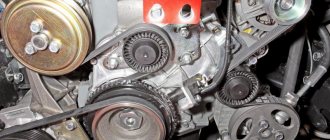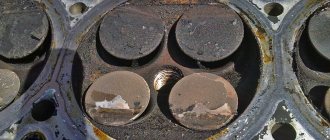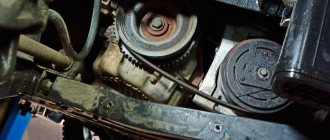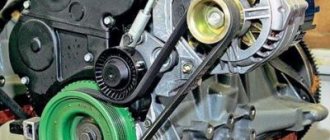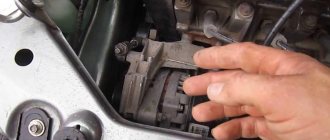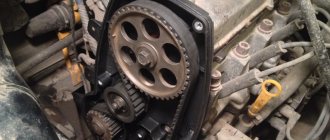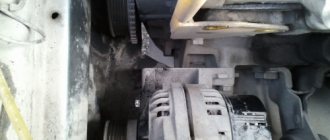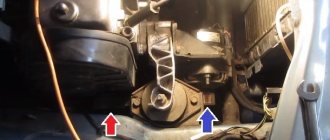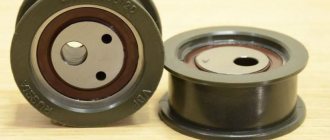Although on many cars the alternator belt is not as important an element as the timing belt, this element still needs to be checked and replaced regularly. The reason is that the generator drive belt allows both the car generator itself and other attachments (power steering, air conditioning compressor, etc.) to operate on cars.
Of course, if the belt breaks or there are any problems with the drive, the power steering, air conditioning, generator and other equipment will not work normally. Extraneous noises, squeaks, whistling of the generator belt, etc. also often appear.
Next, we will look at when to change the alternator belt, how to replace the drive belt, and what features you need to pay attention to as part of this procedure.
When and how to change the V-belt.
The main problem in a car when the drive belts wear out at the initial stage are various creaks and whistles that occur during the rotation of the pulleys transmitting torque to the engine attachments. If these creaks and whistles occur, one of the drive belts may simply break soon. Dear friends and our readers, we offer you detailed information about the types of belts installed in modern cars. Our information directory will help you find out when it is necessary to change drive belts and also how to determine the degree of their wear, how a drive belt differs from a timing belt and what is the average cost of drive belts on the Russian market, and at the same time get for yourself and answers to other questions that interest you directly related to these belts.
First, let's immediately dot the i's and find out what they are - drive belts.
A car drive belt is an element of a belt drive, a specific working part of vehicles and mechanisms that serves to transmit engine torque.
The transmission of torque occurs due to frictional forces or engagement forces (timing belts, V-belts).
There is a misconception that the timing belt (timing belt drive) is not a drive belt. Actually this is not true. The timing belt also falls into the category of drive belts.
Drive belts are divided into several types, namely:
— Timing belt (timing belt drive).
— Drive belts for auxiliary components (engine attachments).
There are 3 (three) types of car belts:
1. Timing belt - as a rule, it is toothed.
2. Poly V-belt transmitting engine torque to engine attachments.
3. V-shaped (V-belt) transmission of engine torque to engine attachments.
Belts No. 2 and No. 3 in our country also have additional names, that is: flat belt (V-ribbed belt) or ripple belt (V-belt).
Unlike timing belts, which are subject to fairly strict requirements, such as mandatory timely scheduled replacement in accordance with the service life established by the manufacturer, drive belts that ensure the operation of engine auxiliary (attachment) equipment do not require such close attention.
But, nevertheless, this does not mean at all that they do not need our attention. They also periodically require scheduled replacement. Moreover, it is not advisable to wait until the belts fail, since these belts ensure the operation of important equipment in the car (cooling, battery charging, air conditioning, etc.).
Thus, if you suddenly hear a squeak or whistle under the hood of your car, we advise you to pay attention to it. Remember that extraneous noise under the hood is not only a nuisance for your hearing, but also something more. If a creaking or whistling noise appears under the hood of the car, this indicates that the drive belt is slipping on the pulleys. For example, if the belt is old, then its tension may be significantly weakened, which causes the belt to slip on the pulleys and produce a squealing noise while the engine is running.
Typically, when a belt is worn out or has loose tension, the slipping or squealing will only worsen in rainy and cold weather as the belt loses its grip on the pulley due to moisture.
If you, friends, heard a single squeak or whistle of a belt under the hood of your car, especially after driving through a deep puddle, then there is no particular reason to worry. In this case, the drive belt is most likely too wet, which has reduced its adhesion specifically to the pulley. If you hear this whistle (squeal) under the hood after starting the car in the morning or after several kilometers, or after starting to drive, or when the engine warms up, then most likely your drive belts (or belt) are worn out or weakened the tension of these drive belts itself.
Function of the drive belt (V-V and poly V-belt)
A V-shaped or poly-V belt is part of the engine drive belts, which serves as an auxiliary component that ensures the functionality of the attachments of the car’s power unit (water pump, air conditioning, generator, hydraulic booster).
The belt rotates due to the torque of the engine during operation. Torque is initially transmitted by the crankshaft of the engine itself. Next, the torque is transmitted through belts and pulleys to auxiliary equipment located under the hood.
For example, a V-belt has a V-shaped cross section, which allows the belt to transmit torque to the vehicle accessory pulleys. This type of belt drive is called V-belt torque transmission.
For example, this type of belt is often used to transmit engine torque to an electric generator that charges the battery.
The rotation of the generator produces electricity, which supports the operation of all electrical equipment in the vehicle.
Also, in many modern cars, this type of belt is also used to transmit torque to the electric power steering, to the cooling fan, to the water pump (coolant pump), to the air conditioning compressor and to the classic power steering wheel. Since this belt is subjected to enormous loads and constant temperature changes, it is made, as a rule, of hard rubber and a metal core, which provides strength and durability to the belt. Also, many belts have a durable textile thread, which allows the belt to withstand the transmission of high torque.
So, friends, remember, each car, in addition to the timing belt (some cars also use a timing chain), has one or more belt drives (depending on the technical features of the car), which ensure the functionality of engine attachments.
If the drive belt is cracked.. (consequences)
If the drive belt (or belts) in your car are worn out, they will have cracks and abrasions on their surface. Eventually, while the car is moving, a whistle will begin to appear. In this case, it should be clear that the time has come for their planned replacement. Remember, friends, that if you do not change the drive belt on time, you risk being left without working car equipment. For example, if a belt has reached the end of its service life due to severe wear and tear, it will naturally break sooner or later.
Typically, when the drive belt breaks, you will hear a loud bang from under the hood. As a result, the equipment receiving torque from it will cease to function. For example, if the drive belt that powers the generator breaks, it will simply stop charging the battery and powering all the electrical equipment of the car. As a result, you will see the battery icon light up on the car dashboard.
Also, if the belt breaks, the power steering will stop working. As a result, your steering wheel will become very difficult to turn. But the most important problem when the drive belt breaks is the lack of rotation transmission to the water pump, which promotes the circulation of coolant through the engine cooling system. As a result, the engine can quickly overheat. In this case, you must immediately stop driving, stop and turn off the engine.
Therefore, friends, while driving, constantly monitor the engine temperature sensor, which should show the same temperature of 90 degrees after the engine warms up. If you notice that the temperature needle on the device has gone up and is approaching the dangerous red zone, then in this case you need to stop, turn off the engine and diagnose the cooling system.
Attention! Overheating of the engine can lead to its premature failure (damage to valve stem seals, head gaskets, and also damage to the piston system). Therefore, friends, do not under any circumstances allow the power unit to overheat; monitor the engine temperature on the dashboard.
What to do when the alternator belt breaks on the road
The first thing you should do is not panic, because there is a way out of any situation. If you are in the city or not far from an auto parts store. You can get to the store without an alternator belt, but you first need to assess the situation.
Some vehicles use an alternator belt drive to rotate the coolant circulation pump. Therefore, if on your car the coolant circulation pump is driven by the alternator belt drive, then driving without an alternator belt on such a car is strictly PROHIBITED. If you start driving such a car, the engine will inevitably overheat and fail.
If the pump on the car is rotated by the timing belt drive, then you can safely continue driving on the battery. For a longer trip, you must turn off all electrical equipment of the car, i.e. turn off the headlights (if you are driving at night, you can turn off one right headlight and continue driving with one headlight, this will save battery power), the interior heater, music, etc. On a well-charged battery, you can travel up to 50 km.
What determines the service life of drive belts?
Modern drive belts have a fairly long service life, all thanks to their design and modern reliable materials. On average, a high-quality belt can last up to 25 thousand hours of operation. Please note that the service life is indicated in hours, and not in kilometers, since the mileage itself does not directly affect the service life of the drive belts. After all, these belts are in motion even when the car is standing still and the engine is idling.
But this is in theory and according to information provided by the belt manufacturers themselves to consumers.
In practice, the service life of drive belts may differ significantly from that declared by the manufacturer. The point is that the wear of drive belts is influenced by many different factors. For example, the way it was installed on the car plays an important role in the long service life of belts. For example, it is not uncommon for car mechanics in technical centers, due to their low qualifications or lack of experience in car repairs, to try to fit a belt onto a pulley using a screwdriver. Ultimately, the new belt will become damaged and will no longer last as long as the manufacturer claims. This method of installing a drive belt is also used when it is necessary to speed up the process of replacing it, so as not to remove the pulley.
In addition, the service life of belts is also affected by the storage conditions of these components in the warehouse and during their transportation. For example, it is not uncommon for car dealerships to sell drive belts that have expired. Yes, drive belts certainly have an expiration date. The point here is this: the chemical composition of the materials of drive belts changes over time, and if the drive belt was produced 5 years ago and was incorrectly stored in a warehouse, then when installed on a car it will naturally not last very long.
Weather can also affect the durability of belts in a car. For example, if you live in a region with a hot climate, then you often use air conditioning. This means that the air conditioning compressor must then receive more of the required energy. As a result, this belt, which transmits torque to the air conditioning compressor, begins to experience increased load.
In particular, drive belts can quickly wear out if the machine is operated for a long time in cold and damp weather. For example, in winter, the electrical equipment of a car requires more power than in warm and dry weather.
As a result, the alternator requires more energy to maintain the electrical system in the vehicle. Ultimately, the alternator belt begins to experience increased stress due to increased torque.
As a rule, these drive belts last longer in a new car because they were installed at the factory and all the necessary storage conditions were observed before they were installed. Once the factory drive belts are replaced, the service life of the newly installed belts will be reduced.
Each car manufacturer in the technical documentation and in the car service book usually indicates in routine maintenance the date when it is necessary to regularly replace the drive belts. Therefore, we advise you, friends, to carefully read the list of scheduled technical inspections and the regulations for replacing consumables. As a rule, the manufacturer indicates the maximum mileage at which the drive belts must be replaced at a car mechanic's technical center. Thus, you will approximately know for yourself the maximum service life of drive belts. But this does not mean that you should not regularly inspect the condition of the belts. More on this below.
Signs and symptoms
There are six main signs that the timing belt has jumped.
- The car engine is unstable.
- The engine constantly stalls.
- Noticeable loss of engine power and thrust.
- The engine starts with problems or does not start at all.
- The power plant is stuck.
- The sound of the engine becomes louder - a metallic knock appears.
Most often, it happens that the product jumps one tooth, and because of this, the engine continues to operate, but increases fuel consumption, and there are also interruptions in operation and starting.
If you suspect that several teeth have jumped, you should not restart the engine. In the worst case, this can cause the valves to bend.
Regularly checking drive belts
Periodically, every car owner should check the condition of all drive belts and their tension. To do this, check the belts with your finger while the engine is off. For example, by pressing your finger on the belt, you can understand for yourself whether the belt drive tension has loosened or not. Remember that the belt should not move during this inspection (move 1 - 2 cm). If you see something like this, then the cause is weak belt tension. You should also inspect the belt by touch for damage, and a visual inspection is also necessary for chips, cracks and torn elements on the belt.
To do this, use a flashlight, which will not only make your vision better, but can also help you identify worn areas on the belt (as a rule, worn areas of the belt will shine).
In any case, if you see damaged areas on the belt, then it must be replaced with a new one. Please note that when purchasing new drive belts you do not need to purchase original consumables. Today there are many non-original belts on the market, which are often even superior in quality to factory originals. For example, it has proven itself to be the largest supplier of drive belts.
The average cost of replacing a belt in a car repair shop is approximately 2,500 thousand rubles. The cost of car belts itself depends on the popularity of the brand and the cost of the product. There are both cheap drive belts on the market and expensive ones that have a special design and are able to withstand extreme loads.
We check the condition of the alternator belt ourselves
To make sure that the belt is in good condition, you need to perform simple steps. Initially, fifth gear is engaged. On it, leaning on the front bumper, we try to push the car back. At the same time, we are trying to conduct a visual inspection of the belt along its entire length.
All the grooves have been cut off, the belt is on the verge of breaking
There, according to the general rule, there should be no cracks, even the smallest ones, as well as ruptures and peelings that occur due to long-term use of rubber products.
This belt is no longer any good.
If such problems are found, the belt must be replaced. The timing belt is checked in the same way.
It is also a good idea to check the external condition of the generator itself, since its quality raises questions. Don't forget to inspect the generator roller.
The belt is already bad, but the generator pulley is still good
Alternator belt replacement process
Standard article number for alternator belt: 1118-1041020-07
- The length of this belt is 823 millimeters.
- You can find it in the catalog by name or by your own unique number 1118-1041020-07.
- The marking on the box will indicate the index 6РК 823.
In addition, prepare in advance a sufficiently long screwdriver, as well as a “13” key. You may also need a knife to remove the old belt.
- To begin with, we remove the old belt, or what is left of it. As we have already said, this needs to be done every thirty thousand kilometers, even if the condition of the belt appears to be completely satisfactory. The belt can be removed with a simple knife.
- Now we find the bolt for the lower mounting of the generator. Try to unscrew it literally a few turns, which will help with the “13” key.
- Use the same key to unscrew the nut, after which the bolt for the upper mounting of the generator is completely pulled out.
- Now you need to be very careful. You must try to rotate the generator so that the upper eye exactly goes beyond the surface of the protrusion located on the bracket. We confidently press the generator to this bracket and fix it there with ordinary wire. It is best to tie it to the cylinder head cover mounting nut.
- Now carefully put the belt on the generator pulley, as well as on the surface part of the generator drive pulley.
- We engage fifth gear again, while simultaneously pressing the belt against the pulley. In this position, we try to push the car back until the belt is completely in place.
- Now you can untie the wire and start squeezing the generator with a screwdriver in the place where it came into contact with the bracket. Don't forget to insert the top bolt that mounts the generator.
After this, all that remains is to take care of tightening the lower bolt and the nut of the upper generator mounting bolt. This will be enough to set everything in place.
Alternative options
Of course, many car enthusiasts are well aware of the consequences of not having a belt tensioner. The fact is that the belt, quite often, is overtightened, which leads to too rapid wear of the generator bearing. You can recognize this problem by a characteristic sound reminiscent of a howl. This design flaw can be eliminated by installing a generator belt tensioner. The most common option is to install a tensioner from the Lada Kalina.
Installing the alternator belt tensioner
The reason for abandoning the tensioner is simple. The manufacturer tried to save additional money by making the car one of the most affordable in the world. And this is typical only for the cheapest trim levels (standard and norm), which are supplied with eight-valve power units.
To make it easier to control the belt tension, you can simply replace the generator bracket by pre-modifying it.
On the left is a bracket with a tensioner from Kalina, on the right is the standard version from Granta
In the standard bracket you will not find holes for the tensioner pulley. Instead, you can assemble a new bracket, which will be based on the base of the first generation Lada Kalina. As we already said, we will need:
- the bracket itself is from the specified car,
- tension roller,
- tensioner pulley bracket,
- as well as the alternator belt itself, all from the same Lada Kalina of the first generation.
- In addition, do not forget about purchasing a screw tensioner, the corresponding bushing and bolt.
The replacement process itself is similar to replacing standard Lada Granta parts. However, if you do not have the appropriate technical knowledge, then you should contact a service center to assemble the structure.
How to tension, tighten or loosen a drive belt
If the cause of the whistle, squeal or squeak is actually a belt that has become loose and as a result slips on the pulleys, and if the belt does not have any signs of wear or damage, then to remove the extraneous sound you just need to tighten the belt.
Using the same example of a generator belt, this is done using a special adjusting bolt (on modern cars) or using an adjusting bar (on older cars).
For example, to tighten the alternator belt on a modern car, you need to do the following:
— Slightly loosen the generator mounting bolts (upper and lower fastenings).
— Turn the adjusting bolt clockwise, thereby moving the generator away from the engine block and immediately check the belt tension level.
— Then, tighten the nuts of the generator fastening elements.
Please note that in some vehicle systems, the process of tensioning the drive belts is too labor-intensive and requires the use of special tools.
Attention . New generation poly-V-ribbed elastic belts are currently widespread on the market, as well as in many cars. For example, one of the world's well-known manufacturers of such belts is currently. Their products have proven themselves to be the best today. This company is an official supplier for many car factories. Elastic poly V-belts do not require tensioning, tightening, etc. manipulation. Due to their design and material, such belts do not stretch. As a rule, such drive belts last a long time, approximately 120 thousand kilometers.
But for its (their) initial tension a special tool is needed.
In many cars, special belt tension rollers are also used for this, which saves drivers from constantly tightening these belts. The only drawback of this design, as a rule, is that when replacing drive belts, it is also necessary to change the tension roller itself, since its reuse together with a new belt is impossible.
Features of adjusting and tightening the generator belt
Now let's look at how to properly tension the alternator belt. I would like to note that the whole process takes no more than 10-15 minutes. Therefore, going to a service station and emptying your wallet to pay for a technician is stupid, to say the least.
Proceed in the following sequence:
Find the tension bar and slightly unscrew the locknut on it, otherwise you simply will not be able to turn the adjusting bolt. If the washer reservoir is in the way, remove it, but this is not necessary.
We rotate the tensioner bolt until the required belt tension is created.
After this, tighten the locknut with the required force, and the work of tensioning the belt on the Lada Kalina is completed; all that remains is to check.
After completing the work, be sure to check that the belt tension is correct (using one of the methods we mentioned above) and that the generator is operating normally.
To do this, turn on the ignition and carefully inspect the instrument panel (the corresponding battery charging indicator should light up on it).
Now you can start the engine and let the car run for a while. All this time, watch the indicator - after a few seconds it should go out.
Remember that even a beginner can adjust the belt. The main thing is to strictly follow the testing scheme and do not forget to diagnose the tension from time to time.
Replacing drive belts at a technical center
Modern cars today are equipped with sophisticated technologies and new complex engines with additional equipment. Most modern vehicles have very, very little space under their hood. In some cars there is simply no free space under the hood. Therefore, replacing drive belts in new cars yourself is not so easy. After all, in order to replace drive belts, it is necessary to dismantle many attachments. And all this just to get to the belts themselves.
Typically, replacing drive belts along with rollers may take about 1.5 - 2 hours. The average cost of an hour in Russia is currently about 35 - 50 US dollars. Accordingly, the cost of replacing belts can range from approximately 2,500 to 9,000 thousand rubles (depending on the technical center, make and model of the car).
In older cars, the process of replacing drive belts usually lasts no more than half an hour, since due to the simpler design of the engine compartment, access to the rollers and belts is more convenient.
Tension control
Normal operation of a belt drive requires no slippage and is ensured by adequate tension. Due to the difficulties of directly measuring it without specialized measuring instruments, control is performed indirectly.
The tension is considered sufficient if the amount of deflection when pressing strongly on the belt of a new ribbed or V-belt in the area of its longest free part between two pulleys does not exceed 2 mm. Over time, due to fatigue phenomena, an increase in deflection of up to 5 mm is permissible. When checking, a ruler is applied to the plane of the belt, and pressure can be created with the leg of a caliper, which has a scale.
In the case of a toothed belt with constant mesh, the deflection is replaced by a lateral rotation: the deflection angle of the working surface plane should not exceed 90 degrees.
Regardless of the version, it is recommended to check the tension on a new car and check it every 20 - 30 thousand kilometers.
How can I remove the whistling, squeaking or crackling sound coming from the belt under the hood?
Unfortunately for us, eliminating belt squeal by tightening does not always help. In this case, you need to replace the old belt with a new one. But many car owners prefer to delay this process itself for as long as possible. To do this, they purchase various sprays from auto stores that they spray on belts. As a result, to the surprise of many specialists and others, this helps.
But again, unfortunately, not for long. Some craftsmen even suggest using a screwdriver and a piece of soap to process the side surface of the belt while the engine is running. For our part, we categorically do not recommend doing this, since, on the one hand, it is very dangerous to carry out any work with rotating components while the engine is running, and on the other hand, the effect of such similar old-fashioned methods is short-lived.
Symptoms of tensioner failure
Signs indicating malfunction or wear of the relevant parts:
- no battery charge indicator;
- a whistle or squeak in the area of the working area of the generator belt, appears when it slips in cases where the tension roller is jammed;
- a hum that sounds when a bearing wears out or fails;
- vibration of the belt or roller when the engine is running indicates wear of the bushing, replacement of which is inevitable;
- the amount of belt deflection exceeds one and a half centimeters, which indicates the need for appropriate adjustment;
- free play in the tension pulley or roller indicates that the bearing is worn out;
- one side of the belt is more stretched and worn, a sign of a bend in the tensioner bracket.
V-shaped - V-belt, poly-V-belt and toothed belt - what is the difference?
The drive belts of engine attachments should not be confused with timing belts, which synchronize the operation of the valves in the cylinder head with the piston system of the engine block using the camshaft.
As a rule, the timing belt is made of a completely different material from the drive belts of the same generator and other auxiliary equipment. Also, in some cars, the water pump drive is driven not by the V-belt or poly-V belt itself, but specifically by the timing belt, which, due to the special design of the engine, in addition to powering the water pump, also synchronizes the operation of the valves with the pistons.
The timing belt is made from a plastic composite material and has many special teeth that protect the belt from slipping. This is necessary so that the valves work synchronously with the piston system itself and do not collide with each other. After all, many of us motorists already understand that if the timing belt slips and the timing of the gas distribution mechanism goes wrong, the engine will not be able to work or will simply fail.
The timing belt also tends to stretch and has a maximum service life. This belt requires closer attention from the motorist, since if it wears out or breaks, the car’s engine can be seriously damaged and damaged, which will ultimately lead to huge financial costs.
Read more about this here.
Signs of a bad timing belt
Unlike a chain drive, there are no obvious external signs of a timing belt failure. But there are a few indirect ones that are worth mentioning:
- Increased engine temperature. Shift in valve timing due to a stretched belt sometimes affects the normal operation of the engine by increasing operating temperature.
- Increased fuel consumption with a simultaneous decrease in power characteristics. The reason is the same - an overstretched belt.
- Rough engine operation or starting problems for no apparent reason. Sometimes a worn belt skips one or more teeth, causing significant engine problems.
If your car has the ability to remove the protective cover without complicated manipulations, take the time to check the condition of the timing belt. Cracks, loose threads, and damaged teeth are the main signs of a faulty timing belt.
